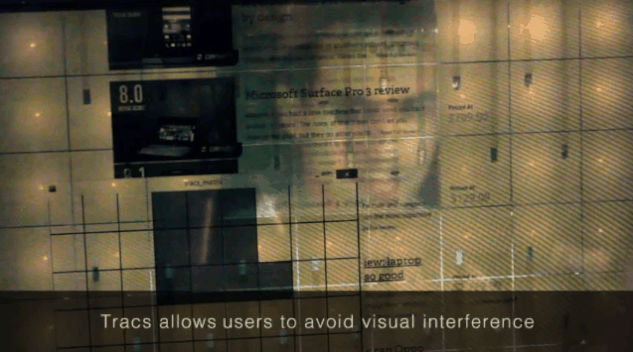7 experimental interfaces of the future
- Transfer

Yesterday in Honolulu began the 27th Software and Technology Symposium (Software and Technology Symposium). Dozens of companies and development teams presented all sorts of experimental interface designs. Some of the most interesting and promising of them, having great chances for mass adoption, are presented under the cut.
Light ring
The Light Ring project is being developed by specialists from Microsoft Research. The compact device uses infrared radiation to detect finger movements, and the gyroscope helps to track the position in space. As a result, you can turn literally any surface into a keyboard. You can click, drag and draw on the table, book, knee or wall. So far, the device recognizes the movement of only one finger, but it is very accurate and fast.
Room alive
Another development of Microsoft Research, which is a follower of the IllumiRoom project , introduced back at CES 2012. The Kinect projectors and set-top boxes group turns the surface of all objects in the room into a single interactive surface.
Skin buttons
The development team from Carnegie Mellon University presented its vision of expanding the active control zone for wearable watches. To do this, it is planned to incorporate miniature projectors into the gadget, which display different control icons directly on the user's hand around the clock. The developers note that the projection module costs only $ 2, while it can even increase the battery life by depriving the screen of control functions.
Flexense
The FlexSense project is being developed by the Austrian Media Interaction Laboratory. The device is a sheet of transparent flexible plastic with integrated piezoelectric sensors. With their help, the control system with fairly high accuracy determines the curvature of the plastic sheet. This allows you to create interfaces based on a natural and familiar pattern of interaction with plain paper.
Tracs
This is a two-sided display with dynamically changing layer transparency. As conceived by the developers, this facilitates and accelerates the establishment of eye contact with a colleague sitting opposite you.
Tegi
Teegi is the name of the doll, which visualizes the brain of the user with its behavior. The name itself is an acronym for Tangible ElectroEncephaloGraphy Interface, "tangible electroencephalographic interface." This strange development was created as a visual educational tool for studying brain activity. Using this technology, it is quite possible to create a device management interface, including for use by paralyzed people. And work in this direction has long been underway.
Haptomime
One of the most interesting projects presented at the symposium. The device uses ultrasound to create tactile sensations for use at a small distance from the device. Just raising your hand, but not touching, you feel with your skin the surface of the projected image.
